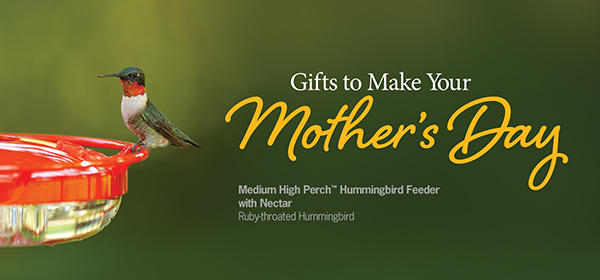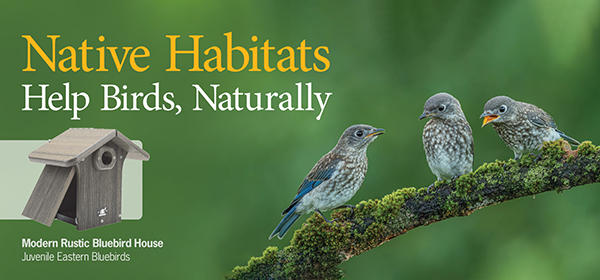Wild Birds Unlimited in Winchester will be closed on Monday, May 27th, for the Memorial Day Holiday
Shop Wild Birds Unlimited for the Perfect Mother's Day Gift
Finding the perfect Mother's Day gift can be a challenge. Let us help make the job a little easier. From hummingbird feeders that attract "the jewels of nature" to our nature-inspired household and garden items, we have a wide variety of unique gifts sure to make mom smile. Shop now for the best selection of gifts for Mom and Mother Nature.
$10 OFF Purchases of $60 or More*
Promo Code: MOM
*Valid in-store at the participating store(s) listed or by shopping online. One discount per purchase. Offer not valid on previous purchases, gift cards, optics, DSC memberships or sale items. Offer valid thru 05/12/2024
Create a Bird-friendly Habitat in Your Backyard
Scientists have identified habitat loss as one of the biggest reasons for the decline in bird populations. You can make a difference by adding native plants to your yard.
A plant is native if it has occurred naturally in a particular region, ecosystem or habitat without human introduction. Native plants provide shelter and nesting areas for birds, as well as natural sources for nectar, seeds, berries and insects.
Native Plant Facts
- Native plants typically grow healthier and stronger than non-natives.
- Native plants are low maintenance, requiring less watering, fertilizer and pesticides.
- Native plants assist in managing rainwater runoff and maintain healthy soil as their root systems are deep and keep soil from being compacted
For you, native plants add a wealth of beauty, texture, varying heights and bloom times, providing a stunning display over multiple seasons. For birds, native trees and plants are home to caterpillars and other insects, which provide food for nestlings.
Adding native plants is one of the 7 Simple Actions to Help Birds. Stop by the store to learn more about native plants and actions you can take to help #SaveTheSongBirds.
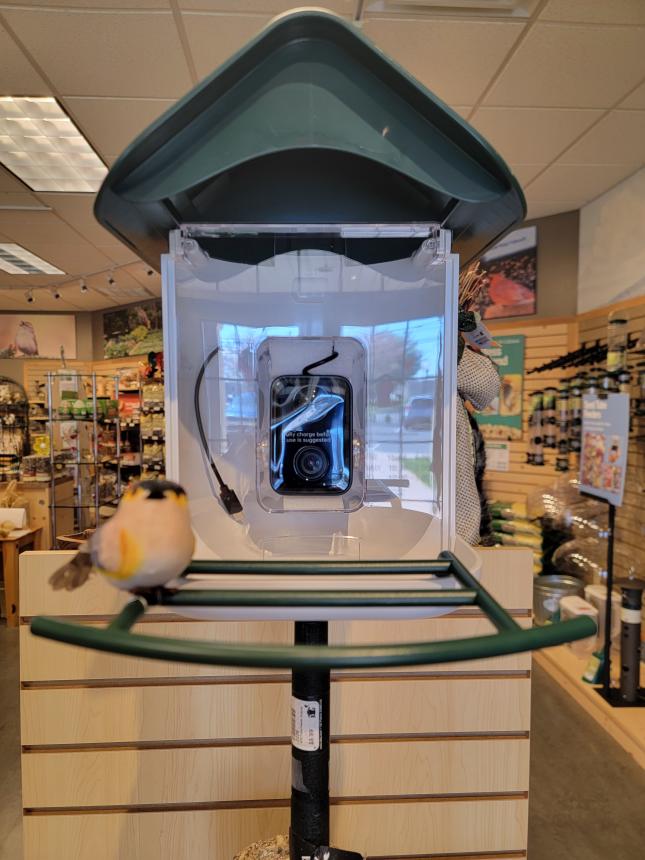
BirdReel Gen2 - Smart Birder with 1080P High-Definition Camera - Forest Green
This is the 2nd generation BirdReel Smart Bird Feeder in Forest Green with the modified base mounting system that is compatible with the APS Pole System using the Tube Feeder Adapter from Holscher.
Introducing the BirdReel Smart Bird Feeder! Now, bird enthusiasts can watch birds feeding from their backyard using their smartphone from anywhere in the world! Say goodbye to wondering about the birds in your area. With BirdReel, you can capture the beauty of bird watching 24x7 with real-time notifications to your mobile phone and live-streaming video.
At BirdReel, we've designed our bird feeder with a user-friendly approach. With a spacious 2-liter hopper and a clear front face, it's effortless to keep track of when it's time to refill your feeder. Unlike other smart bird feeders with small and hard-to-access hoppers, our BirdReel features a simple flip-top cover that adds a touch of fun and makes filling birdseed an easy task!
With Bird Lover, the user-friendly and intuitive companion application, you have the power to watch live video streams of your bird feeder at any time, effortlessly capture stunning pictures and videos, and easily share your memorable moments with friends and family.
Experience our cutting-edge motion detection technology that keeps you informed whenever a bird visits the feeder. With the Bird Detection setting, you'll receive instant notifications as soon as a bird is detected on the feeder. Alternatively, you can utilize BirdReel as a backyard security camera with the Motion Detection option, ensuring the safety and surveillance of your outdoor space.
The Bird Lover app has integrated AI bird recognition, which will make you a bird identification expert in no time. The intelligent AI software can identify more than 10,000 different species of birds from the live-stream, video or pictures with the tap of a button. Bird Lover will even take you to a link to learn more about that bird, including its feeding habits, migratory patterns and more.
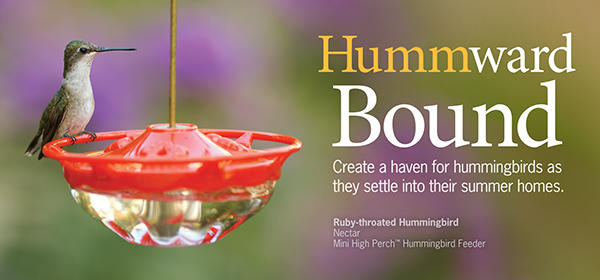
Hummingbird are Worth the Wait
Waiting for something often makes it more exciting.
This is especially true as you anticipate the first glimpse of a hummingbird each spring. The excitement of their arrival at your feeders is guaranteed to bring joy to your heart and a smile to your face.
So be patient and rest assured that hummingbirds are on their way.
Their arduous 2,000 mile journey from Central America will finally end in your own backyard! Indeed, you have won the lottery…and the payout is that these beautiful jewels will continue to brighten your world until the end of summer.
Whether you are on the lookout for Ruby-throated Hummingbirds in the east or Black-chinned, Rufous or Broad-tailed in the west, providing nectar feeders and a variety of appropriate native plants is your best bet to entice these summer visitors.
But not all hummingbirds are on the move.
If you are lucky enough to reside in the far west, you may be hosting a family by now. Hummingbirds such as Costa’s, Anna’s and Allen’s are already busy raising their youngsters. Your anticipation now turns to seeing a glimpse of a newly fledged hummingbird making its first visit to your feeder.
Be it a juvenile or adult hummingbird, watching them at the feeder is always a special treat.
Watch as they fan their tail and dart at one another. Check for a hint of yellow pollen on their forehead from the flowers they have visited. Listen for their chittering or squeaking calls and the incessant hum of their wings. Observe their tongue moving in and out of their bill up to 12 times per second as they lap up the sweet nectar.
Hummingbirds do not feed by sucking up nectar with their bills. They feed by using their forked, open-grooved tongue to draw the nectar into their mouth with every lapping action.
A great way to see this amazing tongue in action is to use a Wild Birds Unlimited Hummingbird Feeder or a WBU Window Hummingbird Feeder. Due to these feeders’ clear plastic bases, you will actually be able to witness the rapid lapping action of your hummingbird visitors.
So many reasons to be impatient for their return…but the payoff is always well worth the wait.
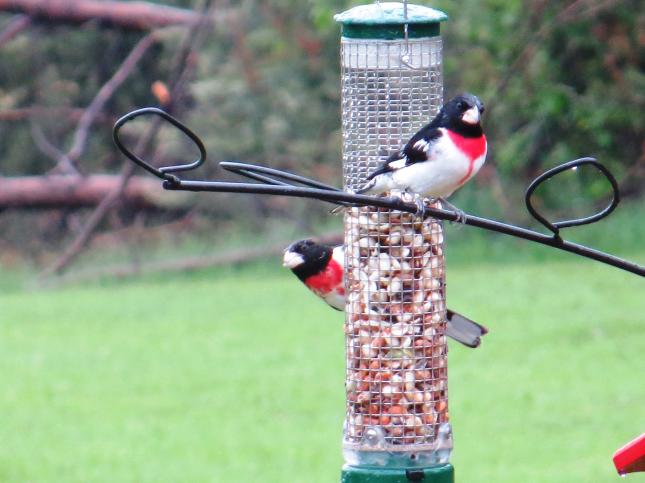
MAY NATURE HAPPENINGS
• Orioles return this month and begin nesting. Get feeders, nectar, jelly and fruit out early.
• Get up early one morning and listen to male birds sing proclaiming their territory as well and announcing their presence to females. This is the “Dawn Chorus”.
• Check out nesting boxes to see what songbirds are building nests or laying their eggs ~ Chickadees, Tufted Titmice, Bluebirds, House Wrens or Tree Swallows. There is still time to put up a nesting box for nesting season.
• Keep a watchful eye for the English sparrow (House Sparrow) aggressively taking over Bluebird and Tree Swallow nesting boxes.
• Broad-winged and Sharp-shinned Hawk migration at its peak early in month. Take a road trip to Hawk Mountain in Pennsylvania.
• Northern Mockingbirds can be heard singing through the night into early summer.
• Ruby-throated Hummingbirds are back building strength from their arduous migration from Central America. Keep the nectar feeders filled!
• Rose-breasted Grosbeaks, Wood Thrushes, Indigo Buntings, and Chimney Swifts return, plus the mimic thrushes ~ Grey Catbirds and Brown Thrashers.
• Sub-adult Purple Martins return to establish new colonies early in month. There is still time to put up Purple Martin houses.
• Nesting materials are being collected, put out some cotton batting, dog hair or nesting balls.
• Look for Cedar Waxwing pairs passing a flower petal, berry, or insect back and forth as a courtship behavior.
• Watch for the male Cardinal to feed the female as part of their courtship behavior.
• Chickadees and titmice become scarce at feeders as they nest and raise their young.
• Pink Lady Slippers, Painted Trillium, and Bunchberry are in bloom.
• Poison Ivy is blooming. Watch for it in flower gardens.
• Monarch Butterflies have arrived and are laying eggs on milkweed plants.
• Yearling Black Bears leave their mothers to find a new home now through July, becoming major nuisances in neighborhoods.
• Before mowing the lawn, walk around your yard to see if there are any rabbit nesting spots. They are usually evident by dead patches of grass.
• Check dead trees before cutting them down for squirrel nests.
• Painted and Snapping Turtles are moving to dry land to lay their eggs; look for them while driving as they cross highways and back roads. If possible give them an assist ~ but only in the direction they are traveling.
May 27, Memorial Day, Wild Birds Unlimited is closed.
You can make a difference. North America has seen a 30% decline in bird populations since 1970. See how you can help.
learn more

